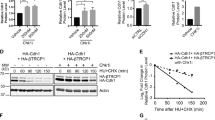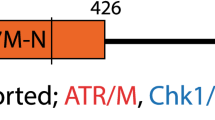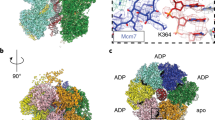Abstract
The initiation of eukaryotic DNA replication is regulated by three protein kinase classes: cyclin-dependent kinases (CDK), Dbf4-dependent kinase (DDK) and the DNA damage checkpoint kinases1. CDK phosphorylation of two key initiation factors, Sld2 and Sld3, promotes essential interactions with Dpb11 (refs 2–4), whereas DDK acts by phosphorylating subunits of the Mcm2-7 helicase5. CDK has an additional role in replication by preventing the re-loading of Mcm2-7 during the S, G2 and M phases6, thus preventing origin re-firing and re-replication. During the G1 phase, both CDK and DDK are downregulated, which allows origin licensing and prevents premature replication initiation3. Origin firing is also inhibited during the S phase when DNA damage or replication fork stalling activates the checkpoint kinases7,8,9,10. Here we show that, analogous to the situation in the G1 phase, the Saccharomyces cerevisiae checkpoint kinase Rad53 inhibits both CDK- and DDK-dependent pathways, which acts redundantly to block further origin firing. Rad53 acts on DDK directly by phosphorylating Dbf4, whereas the CDK pathway is blocked by Rad53-mediated phosphorylation of the downstream CDK substrate, Sld3. This allows CDK to remain active during the S phase in the presence of DNA damage, which is crucial to prevent re-loading of Mcm2-7 onto origins that have already fired6. Our results explain how checkpoints regulate origin firing and demonstrate that the slowing of S phase by the ‘intra-S checkpoint’ is primarily due to the inhibition of origin firing.
This is a preview of subscription content, access via your institution
Access options
Subscribe to this journal
Receive 51 print issues and online access
$199.00 per year
only $3.90 per issue
Buy this article
- Purchase on Springer Link
- Instant access to full article PDF
Prices may be subject to local taxes which are calculated during checkout




Similar content being viewed by others
References
Bell, S. P. & Dutta, A. DNA replication in eukaryotic cells. Annu. Rev. Biochem. 71, 333–374 (2002)
Tanaka, S. et al. CDK-dependent phosphorylation of Sld2 and Sld3 initiates DNA replication in budding yeast. Nature 445, 328–332 (2007)
Zegerman, P. & Diffley, J. F. X. Phosphorylation of Sld2 and Sld3 by cyclin-dependent kinases promotes DNA replication in budding yeast. Nature 445, 281–285 (2007)
Masumoto, H., Muramatsu, S., Kamimura, Y. & Araki, H. S-Cdk-dependent phosphorylation of Sld2 essential for chromosomal DNA replication in budding yeast. Nature 415, 651–655 (2002)
Sheu, Y. J. & Stillman, B. The Dbf4-Cdc7 kinase promotes S phase by alleviating an inhibitory activity in Mcm4. Nature 463, 113–117 (2010)
Diffley, J. F. X. Regulation of early events in chromosome replication. Curr. Biol. 14, R778–R786 (2004)
Shirahige, K. et al. Regulation of DNA-replication origins during cell-cycle progression. Nature 395, 618–621 (1998)
Santocanale, C. & Diffley, J. F. X. A. Mec1- and Rad53-dependent checkpoint controls late-firing origins of DNA replication. Nature 395, 615–618 (1998)
Larner, J. M. et al. Radiation down-regulates replication origin activity throughout the S phase in mammalian cells. Nucleic Acids Res. 27, 803–809 (1999)
Painter, R. B. & Young, B. R. Radiosensitivity in ataxia-telangiectasia: a new explanation. Proc. Natl Acad. Sci. USA 77, 7315–7317 (1980)
Tercero, J. A. & Diffley, J. F. X. Regulation of DNA replication fork progression through damaged DNA by the Mec1/Rad53 checkpoint. Nature 412, 553–557 (2001)
Lopes, M. et al. The DNA replication checkpoint response stabilizes stalled replication forks. Nature 412, 557–561 (2001)
Desany, B. A., Alcasabas, A. A., Bachant, J. B. & Elledge, S. J. Recovery from DNA replicational stress is the essential function of the S-phase checkpoint pathway. Genes Dev. 12, 2956–2970 (1998)
Segurado, M. & Diffley, J. F. X. Separate roles for the DNA damage checkpoint protein kinases in stabilizing DNA replication forks. Genes Dev. 22, 1816–1827 (2008)
Jares, P., Donaldson, A. & Blow, J. J. The Cdc7/Dbf4 protein kinase: target of the S phase checkpoint? EMBO Rep. 1, 319–322 (2000)
Kamimura, Y., Tak, Y. S., Sugino, A. & Araki, H. Sld3, which interacts with Cdc45 (Sld4), functions for chromosomal DNA replication in Saccharomyces cerevisiae . EMBO J. 20, 2097–2107 (2001)
Kanemaki, M. & Labib, K. Distinct roles for Sld3 and GINS during establishment and progression of eukaryotic DNA replication forks. EMBO J. 25, 1753–1763 (2006)
Hardy, C. F., Dryga, O., Seematter, S., Pahl, P. M. & Sclafani, R. A. mcm5/cdc46-bob1 bypasses the requirement for the S phase activator Cdc7p. Proc. Natl Acad. Sci. USA 94, 3151–3155 (1997)
Tercero, J. A., Longhese, M. P. & Diffley, J. F. X. A central role for DNA replication forks in checkpoint activation and response. Mol. Cell 11, 1323–1336 (2003)
Santocanale, C., Sharma, K. & Diffley, J. F. X. Activation of dormant origins of DNA replication in budding yeast. Genes Dev. 13, 2360–2364 (1999)
Alcasabas, A. A. et al. Mrc1 transduces signals of DNA replication stress to activate Rad53. Nature Cell Biol. 3, 958–965 (2001)
Paulovich, A. G. & Hartwell, L. H. A checkpoint regulates the rate of progression through S phase in S. cerevisiae in response to DNA damage. Cell 82, 841–847 (1995)
Falck, J., Mailand, N., Syljuasen, R. G., Bartek, J. & Lukas, J. The ATM-Chk2-Cdc25A checkpoint pathway guards against radioresistant DNA synthesis. Nature 410, 842–847 (2001)
Kim, Y. & Kipreos, E. T. Cdt1 degradation to prevent DNA re-replication: conserved and non-conserved pathways. Cell Div. 2, 18 (2007)
Heffernan, T. P. et al. Cdc7-Dbf4 and the human S checkpoint response to UVC. J. Biol. Chem. 282, 9458–9468 (2007)
Liu, P. et al. The Chk1-mediated S-phase checkpoint targets initiation factor Cdc45 via a Cdc25A/Cdk2-independent mechanism. J. Biol. Chem. 281, 30631–30644 (2006)
Sansam, C. L. et al. A vertebrate gene, ticrr, is an essential checkpoint and replication regulator. Genes Dev. 24, 183–194 (2010)
Kumagai, A., Shevchenko, A. & Dunphy, W. G. Treslin collaborates with TopBP1 in triggering the initiation of DNA replication. Cell 140, 349–359 (2010)
Sanchez-Pulido, L., Diffley, J. F. X. & Ponting, C. P. Homology explains the functional similarities of Treslin/Ticrr and Sld3. Curr. Biol. 20, R509–R510 (2010)
Gilbert, C. S., Green, C. M. & Lowndes, N. F. Budding yeast Rad9 is an ATP-dependent Rad53 activating machine. Mol. Cell 8, 129–136 (2001)
Acknowledgements
We are grateful to K. Bousset, M. Godinho Ferreira, D. Quintana and C. Santocanale for early contributions to this project. We thank J. Gannon and T. Hunt for providing recombinant cyclin A/Cdk2, N. O’Reilly and the Peptide Synthesis Facility at the London Research Institute for the peptide arrays, and D. Toczyski for sharing information before publication. Work was supported by Cancer Research UK.
Author information
Authors and Affiliations
Contributions
P.Z. and J.F.X.D. conceived and designed experiments and wrote the paper. P.Z. performed all experiments.
Corresponding author
Ethics declarations
Competing interests
The authors declare no competing financial interests.
Supplementary information
Supplementary Information
This file contains Supplementary Figures 1-7 with legends, Supplementary Tables 1-3 and a list of Genotypes. Supplementary Figure 7b and legend were amended on 05 May 2011. (PDF 1276 kb)
Rights and permissions
About this article
Cite this article
Zegerman, P., Diffley, J. Checkpoint-dependent inhibition of DNA replication initiation by Sld3 and Dbf4 phosphorylation. Nature 467, 474–478 (2010). https://doi.org/10.1038/nature09373
Received:
Accepted:
Published:
Issue Date:
DOI: https://doi.org/10.1038/nature09373
This article is cited by
-
Analysis of the expression and prognostic significance of DDK complex in Hepatocarcinoma
BMC Cancer (2023)
-
Structural mechanism for the selective phosphorylation of DNA-loaded MCM double hexamers by the Dbf4-dependent kinase
Nature Structural & Molecular Biology (2022)
-
Unscheduled DNA replication in G1 causes genome instability and damage signatures indicative of replication collisions
Nature Communications (2022)
-
Yeast Stn1 promotes MCM to circumvent Rad53 control of the S phase checkpoint
Current Genetics (2022)
-
The yeast Dbf4 Zn2+ finger domain suppresses single-stranded DNA at replication forks initiated from a subset of origins
Current Genetics (2022)
Comments
By submitting a comment you agree to abide by our Terms and Community Guidelines. If you find something abusive or that does not comply with our terms or guidelines please flag it as inappropriate.



